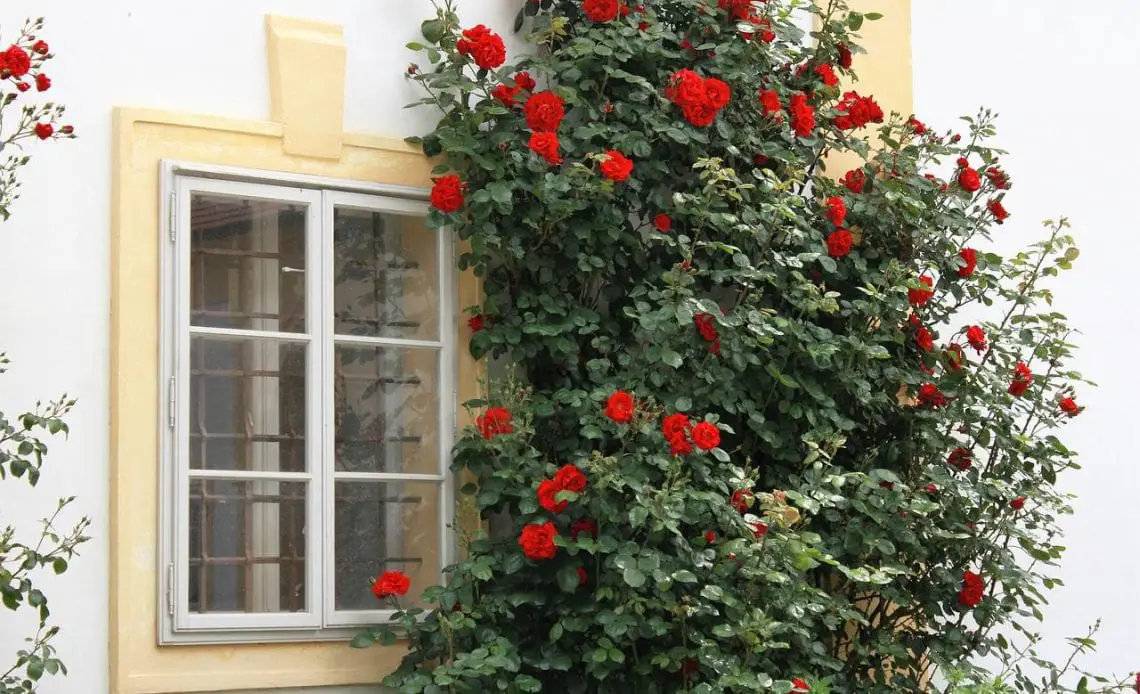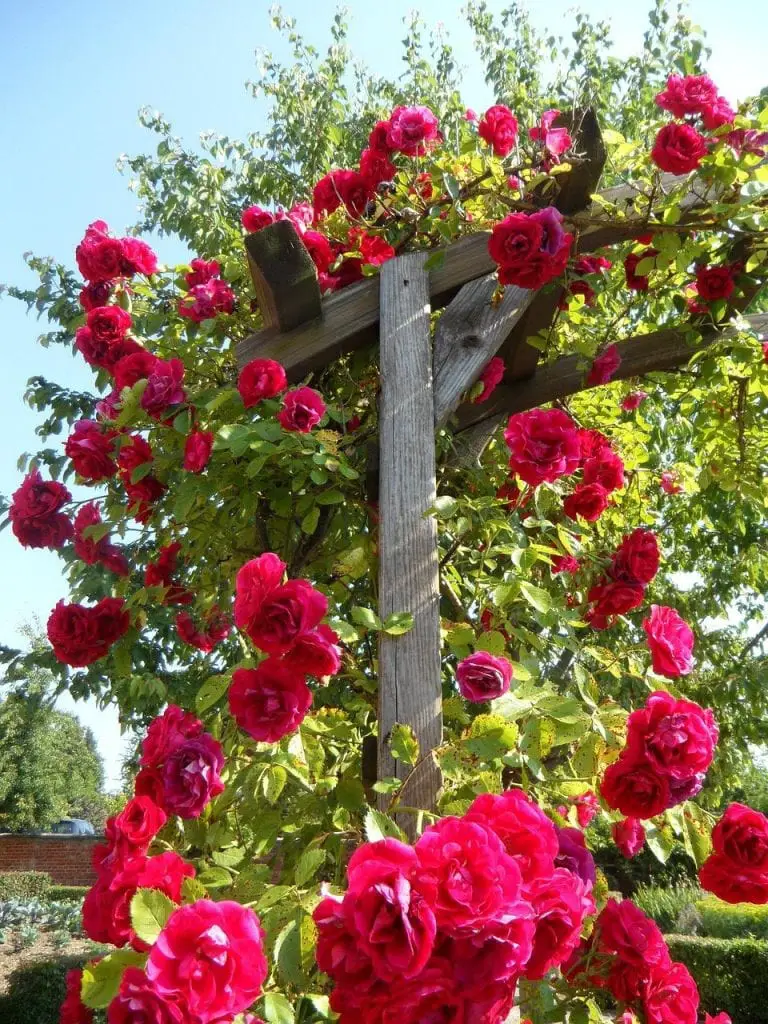
The rose (belonging to the Rosacea family) is one of the most popular flowering plants in the world. The rose is associated with beauty and love. No garden would be complete without a rose plant in it. Climbing roses are a great addition to the garden. You can grow them to climb onto fences, walls, or gazebos to enhance the looks of your garden. Did you know you could grow climbing roses in pots? If the idea appeals to you, then we tell you how to do this.
Which roses to grow in a pot?
Climbing roses can grow up to 12 feet in height. This may make you think whether it is apt to grow it in pots or containers. The answer is yes, you can do this! You need to select the right kind of species that do not require deep roots. If you select the wrong species, then the root would grow so deep that it won’t fit into a pot.
- If you have small pots, you can grow species like Stars ‘n Stripes, Sweet Dream, or Raspberry Royale. The pot needs to be at least 30 cm x 30 cm.
- If you want mid-size pots, you can choose pots of 45 cm x 45 cm. The species to consider are Nice Day, Robin Redbreast, or Flower carpet Royal.
- You can even use large pots of dimensions of 60 cm x 60 cm. The species to grow can be Open Arms, Lady of Shalott, or Jeanne Lajoie.
When to plant climbing roses in pots?
You can plant climbing roses in pots throughout the year. There is no specific season to do this. However, avoid doing it during the snowy season or during heavy rains. The ground can be frozen or waterlogged. This may affect the growth of the plant.
Where to plant?
You need to find an ideal location for your potted climbing rose plant. Roses are versatile in nature and can adapt to the place where you keep them. However, if you want the plant to grow to its best, then you need to choose a location where the plant can flourish. You can keep these guidelines in mind to decide the location for your pot:
- The location should be such that the rose gets sunlight for a minimum of four hours each day. Try to place it in a place where it can get light from the morning sun, which is best for it. This ensures it can grow the best.
- If you stay in a very hot area, keep the pot in an area with shade. It is better if you can keep the pot in an area with shade during the noon hours when the heat is at its peak. Too much heat can affect your potted climbing rose.
- The rose you are planting is a climbing rose, so it needs support to climb. Without this support, it can fall. You need a structure to support the plant, it can be something as simple as a stick or a wall or a fence. You should tie the stem to the structure as it needs strong support during the initial growing period.
- Climbing roses grow taller than most other potted plants. They need sufficient root space. Avoid keeping other potted plants too close to this plant. Too many plants close by can cause competition between roots causing growth problems.
Choosing the pot
The pot you choose needs to have drainage holes at the bottom. You need to move the plant to larger pots as they grow in size. Make sure you have the right type of pots ready in advance. Choose the pot size based on the plant species. Understand the size of the plant and the extent of its roots. If you plan to plant low-maintenance roses, you can use glazed or plastic pots, else you will need to water the plant daily.

Growing mix for the plants
You need a growing mix for your climbing rose that has sufficient organic matter to facilitate good growth. Avoid using normal garden soil. The problem with this soil is pathogens can attack your roses and cause problems. Drainage also may be a problem. Ideally get a potting mix that has perlite in it. You can even mix perlite and commercial potting mix in equal ratios to make the growing mix.
The benefit of using perlite is that it allows good aeration as well as drainage for your roses, allowing them to grow their best. Using a combination of perlite and potting mix is recommended. This allows the roots to easily penetrate the soil and can spread through your mixture. This is great for the plant’s growth.
How to plant the rose in the pot?
First, make sure you have everything ready. Let’s run through the checklist of things you need:
- The pot or container.
- The rose plant of your choice.
- The growing mix.
- Buckets or containers.
- Mulch.
- Commercial plant food.
- A trellis
- Gravel
- Gloves.
- A wire to tie the plant to the supporting structure. Use floral wires that are flexible.
- Trowel.
Here’s how you can plant the rose in the pot:
- Decide the location as per the guidelines mentioned above and keep it ready. As mentioned, avoid keeping too many pots or plants close by.
- Choose the pot based on the rose species and ensure the pot is tall enough to accommodate the roots. Avoid using plastic pots as they can get heated up fast. If you have to use plastic, use a light-colored plastic pot so it doesn’t heat up fast. As mentioned above, ensure drainage holes are present in the pot.
- Place gravel one inch deep at the bottom of the container before loading it with the potting soil.
- As mentioned, use a growing mix using perlite and potting mix. You can also add garden compost to it, in case if you have maintained compost in your garden. The ideal balance of the potting mix will ensure your plant grows well.
- You can keep the rose in a solution of water and planting food while you prepare the pot for use. This is required on a hot day to prevent the plant from dying while you prepare the pot.
- Fill the pot up to two-thirds level with the potting mix. Use garden gloves while adding the potting mix. In the center of the pot, create a mound and place the rose plant on it, making sure the roots spread out. Press the roots in place firmly but gently without applying too much of force.
- Insert a trellis (a wooden or metal structure that supports the climbing plant) into the edge of the pot. Don’t place it near the center as it can damage the roots. Make sure the trellis is firmly secured in place so it can support the plant. You can, later on, allow the plant to climb on to a fence, wall, or any other structure. This can be done once the plant grows sufficiently tall. Until then, the trellis is needed for support.
- Fill the pot now with the potting mix. You need to add water to the pot to form a watery mix. This is needed to ensure the plant gets water immediately to prevent it from drying. You will observe water coming out from the drainage holes.
- Once the pot is filled with the potting mix, cover it with a layer of mulch. At least have one inch of mulch. Spread the mulch over the plant.
- Now you need to water the plant daily for at least two weeks. After this period, do it for two more weeks this time on alternate days. Once the plant starts to grow out from the bud, reduce the watering frequency. Take care to prevent waterlogging, as it can spoil the plant and may make it prone to disease.
- You may need to adjust the pot so that the rose reaches towards the sunlight during the daytime.
- Wait for the plant to grow a bit so that the stem is sufficiently long. From this stage on, the plant growth will take off. Without support, it can fall off. So tie the rose stem to the trellis using a flexible floral wire. Prune the rose and clean the soil to remove fallen leaves and petals.
- Use plant food as required once it starts growing.
Tips to ensure the best growth of the plant
- Keep pruning the roses as they grow. Pruning is the best thing you can do to make your roses grow tall and good. Cut the plant three or four feet below the highest point up to which you want it to grow. Prune weaker stems to allow it to grow strong.
- To test if the soil has sufficient moisture, you can insert a finger an inch deep. If it feels dry, then it means it needs water.
- Once the plant grows taller than the trellis, look for another stronger support for the roses to climb on. This is why selecting the right initial location is important.
- Once every two to three years, replant your rose into a larger pot to allow it to continue to grow well.
